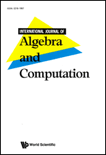
INTERNATIONAL JOURNAL OF ALGEBRA AND COMPUTATION
Scope & Guideline
Exploring the Frontiers of Algebra and Computation
Introduction
Aims and Scopes
- Algebraic Structures and Theories:
The journal focuses on various algebraic structures such as groups, rings, algebras, and modules, exploring their properties, classifications, and interrelations. - Computational Algebra:
It emphasizes the development and application of algorithms in algebra, including computational techniques for solving algebraic problems and implementing algebraic structures. - Geometric and Topological Aspects of Algebra:
Research on the geometric and topological implications of algebraic structures is a key area, including the study of algebraic groups, topological groups, and related geometric properties. - Applications of Algebra in Other Fields:
The journal also explores the application of algebraic methods in areas such as combinatorics, number theory, and physics, showcasing interdisciplinary research that utilizes algebraic frameworks. - Categorical and Homological Algebra:
Works on categorical approaches to algebra, homological dimensions, and derived categories are also featured, highlighting the connections between different algebraic theories.
Trending and Emerging
- Noncommutative Algebra:
There is a noticeable uptick in research focusing on noncommutative algebra structures, including noncommutative rings and algebras, reflecting a growing interest in their properties and applications. - Algebraic Topology and Homotopy Theory:
Emerging themes in algebraic topology and its interplay with algebra are becoming more prevalent, showcasing the increasing relevance of topological methods in algebraic contexts. - Combinatorial Algebra:
The rise of combinatorial techniques in algebra, particularly in the study of algebraic structures like semigroups and graph algebras, is a significant trend. - Computational Techniques in Algebra:
A surge in research applying computational techniques to solve algebraic problems, including algorithm design and computational complexity within algebraic frameworks, is evident. - Quantum Algebra and Noncommutative Geometry:
Research in quantum algebra and its connections to noncommutative geometry is gaining traction, reflecting broader interests in mathematical physics and its algebraic foundations.
Declining or Waning
- Classical Group Theory:
Research specifically focused on classical group theory and its foundational aspects has seen a decline, as the field shifts towards more computational and geometric approaches. - Elementary Number Theory:
The frequency of publications centered on elementary number theory within the journal has decreased, possibly due to the rise of more advanced algebraic methods and computational techniques. - Traditional Algebraic Geometry:
Interest in traditional algebraic geometry topics has waned, with researchers increasingly integrating computational methods or exploring connections with other fields.
Similar Journals
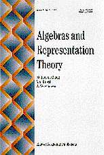
ALGEBRAS AND REPRESENTATION THEORY
Pioneering Theoretical Insights in MathematicsALGEBRAS AND REPRESENTATION THEORY, published by SPRINGER, is a premier journal that focuses on the cutting-edge developments in the field of algebra and representation theory. With an ISSN of 1386-923X and an E-ISSN of 1572-9079, this journal has fostered a robust platform for both established and emerging researchers since its inception in 1998. As a Q1 journal in the Mathematics miscellaneous category for 2023, it stands out for its rigorous peer-review process and commitment to academic excellence. Although it is not an open-access journal, its broad scope includes significant theoretical advancements and applications that resonate across various mathematical disciplines. Located at VAN GODEWIJCKSTRAAT 30, 3311 GZ DORDRECHT, NETHERLANDS, ALGEBRAS AND REPRESENTATION THEORY continues to contribute meaningfully to the scientific community by providing researchers with essential insights and fostering collaboration in the increasingly complex landscape of mathematics. Researchers, professionals, and students are encouraged to engage with the latest publications, as the journal plays a critical role in shaping contemporary discussions and innovations in the study of algebraic structures.

Cambridge Journal of Mathematics
Advancing Mathematical Frontiers with Every IssueCambridge Journal of Mathematics, published by INT PRESS BOSTON, INC, is a premier platform for the dissemination of cutting-edge research in the field of mathematics. With an ISSN of 2168-0930 and E-ISSN 2168-0949, this journal stands out in a competitive academic landscape, currently ranked #58 out of 399 in General Mathematics, placing it in the top 15% within its category according to Scopus metrics. The journal serves as a vital resource for researchers, professionals, and students alike, aiming to foster groundbreaking mathematical inquiries and foster collaboration across disciplines. Published from 2020 to 2024, the Cambridge Journal of Mathematics is committed to maintaining high standards of scholarship, making it an essential read for those who are passionate about advancing mathematical knowledge and its applications.

European Journal of Mathematics
Bridging Theory and Practice in MathematicsWelcome to the European Journal of Mathematics, a prominent publication that serves as a vital platform for disseminating high-quality research in the field of mathematics. Published by Springer International Publishing AG, this journal has witnessed significant growth since its inception in 2015 and is recognized for its contributions within the Q2 category of Mathematics (miscellaneous) as per the 2023 rankings. With an ISSN of 2199-675X and an E-ISSN of 2199-6768, the journal aims to foster innovation and collaboration among researchers, professionals, and students alike. Although it operates under a traditional access model, the journal's commitment to advancing mathematical knowledge and applications cannot be overstated. Positioned among the top-tier publications, the European Journal of Mathematics is an essential resource that encourages the exploration of emerging trends and theories in mathematics, making it indispensable for anyone striving to stay at the forefront of this dynamic field.
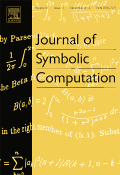
JOURNAL OF SYMBOLIC COMPUTATION
Bridging Theory and Practice in Symbolic ComputationThe JOURNAL OF SYMBOLIC COMPUTATION, published by Academic Press Ltd - Elsevier Science Ltd, serves as a prominent platform for researchers, professionals, and students in the field of mathematics. With an ISSN of 0747-7171 and E-ISSN of 1095-855X, this esteemed journal has been at the forefront of advancing knowledge in symbolic computation since its inception in 1985. The journal is categorized within the Q2 quartile for both Algebra and Number Theory and Computational Mathematics, reflecting its growing influence in these critical areas, as evidenced by its Scopus rankings—ranking 27 out of 119 in Algebra and 104 out of 189 in Computational Mathematics. Researchers can access a wealth of cutting-edge research articles that explore the intricacies of algorithms, algebraic models, and computational methodologies. As it converges towards its 40th anniversary in 2025, the JOURNAL OF SYMBOLIC COMPUTATION continues to be an indispensable resource for advancing theoretical and practical applications in mathematical computation.
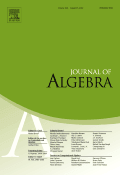
JOURNAL OF ALGEBRA
Exploring the Depths of Algebraic TheoryThe JOURNAL OF ALGEBRA, published by Academic Press Inc. Elsevier Science, is a premier scholarly outlet dedicated to the field of algebra and number theory. With its impressive Q1 ranking in the 2023 category of Algebra and Number Theory and a solid Scopus rank of #46 out of 119, it stands as a crucial resource for researchers and professionals seeking to deepen their understanding of advanced algebraic concepts. Operating since 1964 and continuing through 2025, the journal boasts a rich history of publishing influential research that drives the discipline forward. While the journal does not currently offer open access options, it remains committed to providing high-quality peer-reviewed content to the academic community. Its comprehensive archive and cutting-edge research articles serve as essential tools for students, researchers, and practitioners aiming to stay at the forefront of algebraic studies.
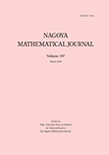
NAGOYA MATHEMATICAL JOURNAL
Advancing Mathematical Scholarship Since 1950NAGOA MATHEMATICAL JOURNAL, published by Cambridge University Press, is a prestigious journal that has been at the forefront of advancing mathematical scholarship since its inception in 1950. With an ISSN of 0027-7630 and an E-ISSN of 2152-6842, this journal has gained recognition for its high-quality research contributions in the field of mathematics, achieving a Q1 classification in Mathematics (miscellaneous) as of 2023. The journal’s impact is further reflected in its Scopus rank of #164 out of 399 in the General Mathematics category, positioning it within the 59th percentile of its peers. Scholars, researchers, and students can access a range of innovative mathematical studies that explore diverse topics, fostering a vibrant dialogue within the mathematical community. By catering to a global audience, the NAGOYA MATHEMATICAL JOURNAL continues to play a critical role in shaping contemporary mathematical discourse and research.

ALGEBRA UNIVERSALIS
Exploring the Depths of Algebraic ThoughtALGEBRA UNIVERSALIS is a prestigious academic journal published by Springer Basel AG, dedicated to the exploration and advancement of mathematical research, particularly within the realms of algebra, number theory, and logic. Established in 1971, this journal continues to provide a platform for innovative research and discourse, contributing significantly to its fields of study over more than five decades. With its current classification in the Q2 quartile for both Algebra and Number Theory and Logic, ALGEBRA UNIVERSALIS ranks prominently within the mathematical community. Although it is not an open-access journal, it offers numerous subscription options for individuals and institutions seeking to stay current with the latest developments and findings. The journal’s commitment to quality research makes it an essential resource for researchers, professionals, and students aiming to deepen their understanding and knowledge of advanced mathematical theories and methodologies.
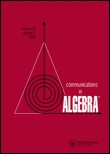
COMMUNICATIONS IN ALGEBRA
Innovating Algebra: Where Theory Meets Practice.COMMUNICATIONS IN ALGEBRA is a prestigious academic journal dedicated to advancing the field of algebra and number theory. Published by Taylor & Francis Inc, this influential journal has been in circulation since its inception in 1974 and continues to provide a platform for innovative research through 2024. With an ISSN of 0092-7872 and an E-ISSN of 1532-4125, it serves a global community of researchers, professionals, and students who are passionate about algebraic studies. The journal is currently ranked in the Q2 category in Algebra and Number Theory for 2023, showcasing its strong impact and relevance within the academic community, as reflected in its Scopus rank of #60 out of 119 and a 50th percentile standing. COMMUNICATIONS IN ALGEBRA aims to publish high-quality, peer-reviewed research articles that not only address current issues in the field but also pave the way for future exploration, solidifying its role as a cornerstone of mathematical literature.

Japanese Journal of Mathematics
Bridging Theory and Application in MathematicsThe Japanese Journal of Mathematics, published by SPRINGER, stands as a premier platform for the dissemination of high-quality research in the field of mathematics. With its ISSN 0289-2316 and E-ISSN 1861-3624, this prestigious journal has been continually contributing to the academic community since its inception. Spanning a broad range of mathematical disciplines, the journal enjoys a strong reputation, recognized in the 2023 category quartiles as Q1 in Mathematics (miscellaneous), placing it among the top-tier journals in the field. Its Scopus rank of #41 out of 399, which reflects an impressive 89th percentile, further underscores its influence and the quality of articles it publishes. The Japanese Journal of Mathematics is dedicated to fostering scholarly exchange and advancing mathematical research, making it an indispensable resource for researchers, professionals, and students alike. Although it does not offer open access, its comprehensive archives provide a wealth of knowledge for those seeking to deepen their understanding of mathematical theories and applications.

Beitrage zur Algebra und Geometrie-Contributions to Algebra and Geometry
Fostering Excellence in Algebra and Geometry ResearchBeitrage zur Algebra und Geometrie - Contributions to Algebra and Geometry is a distinguished journal published by Springer Heidelberg, situated in Germany. With a focus on the intricate fields of Algebra and Number Theory and Geometry and Topology, this journal serves as a pivotal platform for the dissemination of innovative research and critical insights from scholars worldwide. Holding a commendable Q3 category ranking in both disciplines as of 2023, it is recognized for its contribution to advancing theoretical foundations and practical applications. The journal has consistently engaged the mathematical community since its inception in 2000, with a specific publication timeline that spans 2000 to 2002 and 2004 to 2024. Despite its absence of open-access options, the journal's articles are pivotal for researchers, professionals, and students seeking authoritative and impactful studies in algebra and geometry. Join an esteemed readership eager to explore and expand upon the boundaries of mathematical inquiry through this exceptional publication.